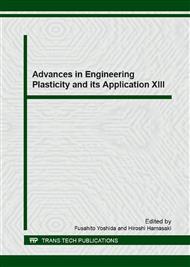[1]
S. P. Keeler, Determination of forming limit in automotive stamping, Soc. of Automotive Engineering, Nr. 650 535, pp.1-9, (1965).
Google Scholar
[2]
Y. Bai, T. Wierzbicki, Application of extended Mohr-Coulomb criterion to ductile fracture, Int J Fract 161: 1–20, (2010).
DOI: 10.1007/s10704-009-9422-8
Google Scholar
[3]
M. Gorji, B. Berisha, P. Hora, F. Barlat: Modeling of localization and fracture phenomena in stress and strain space for sheet metal forming, Int J of Mater Form, DOI 10. 1007/s12289-015-1242-y, (2015).
DOI: 10.1007/s12289-015-1242-y
Google Scholar
[4]
M. Gorji, Instability and fracture models to optimize the metal forming and bending crack behavior of Al-Alloy composites, Diss ETH 23066, (2015).
Google Scholar
[5]
M. Gorji, B. Berisha, N. Manopulo, P. Hora. Effect of through thickness strain distribution on shear fracture hazard and its mitigation by using multilayer aluminum sheets, J Materials Processing Technology, 232: 19-33, (2016).
DOI: 10.1016/j.jmatprotec.2016.01.014
Google Scholar
[6]
P. Hora, L. Tong, M. Gorji, N. Manopulo, B. Berisha: Significance of the local sheet curvature in the prediction of sheet metal forming limits by necking instabilities and cracks. Proceedings of NUMIFORM (2016).
DOI: 10.1051/matecconf/20168011003
Google Scholar
[7]
P. Hora, M. Gorji, B. Berisha, Modelling of fracture effects in the sheet metal forming based on an extended FLC evaluation method in combination with fracture criterions, IDDRG-2016, 18-31, (2016).
DOI: 10.1088/1757-899x/159/1/012030
Google Scholar
[8]
W. Volk, P. Hora, New algorithm for a robust user-independent evaluation of beginning instability for the experimental FLC determination, Int J Mat Forming, 4: 339-346, (2010).
DOI: 10.1007/s12289-010-1012-9
Google Scholar
[9]
F.M. Neuhauser, O.R. Terrazas, N. Manopulo, P. Hora, C.J. Van Tyne, Stretch bending - the plane within the sheet where strains reach the forming limit curve, IDDRG-2016, 94-98, (2016).
DOI: 10.1088/1757-899x/159/1/012011
Google Scholar
[10]
R. Schleich, M. Sindel, M. Liewald, Investigation on the effect of curvature on forming limit prediction for aluminium sheet alloys, International Journal of Material Forming, 2: 69-74, (2009).
DOI: 10.1007/s12289-009-0394-z
Google Scholar
[11]
K. Isik, M. B. Silva, A.E. Tekkaya, P.A.F. Martins, Formability limits by fracture in sheet metal forming, Journal of Processing Technology, 214: 1557-1565, (2014).
DOI: 10.1016/j.jmatprotec.2014.02.026
Google Scholar
[12]
J.H. Kim, J.H. Sung, K. Piao, R.H. Wagoner, The shear fracture of dual-phase steel, International Journal of Plasticity, 27: 1658-1676, (2011).
DOI: 10.1016/j.ijplas.2011.02.009
Google Scholar
[13]
P. Larour, H. Schauer, J. Lackner, E. Till, Edge crack simulation with the modular smiley, tool, 457-477, IDDRG-2016, (2016).
Google Scholar
[14]
D. Mohr, S.J. Marcedet, Micromechanically-motivated phenomenological Hosford-Coulomb model for predicting ductile fracture initiation at low stress triaxialities, Int J of Solids and Structures, 67-68: 40-55, (2015).
DOI: 10.1016/j.ijsolstr.2015.02.024
Google Scholar
[15]
Y. Luo, H. Huh, S. Lim, K. K. Pack, New ductile fracture criterion for prediction of fracture forming limit diagrams of sheet metals, Int J of Solids and Structures, 49: 3605-3615, (2012).
DOI: 10.1016/j.ijsolstr.2012.02.016
Google Scholar
[16]
P. Hora, B. Berisha, M. Gorji, N. Manopulo, A generalized approach for the prediction of necking and rupture phenomena in the sheet metal forming, IDDRG-2012, (2012).
Google Scholar
[17]
T. Wierzbicki, Y. Bao, Y-W. Lee, Y. Bai, Calibration and evaluation of seven fracture models, International Journal of Mechanical Sciences 47: 719-743, (2005).
DOI: 10.1016/j.ijmecsci.2005.03.003
Google Scholar
[18]
A.K. Gosh, Tensile instability and necking in materials with strain hardening and strain-rate hardening, Acta Metallurgica, 25: 1413-1424, (1977).
DOI: 10.1016/0001-6160(77)90072-4
Google Scholar
[19]
J.E. Hockett, O.D. Sherby, Large strain deformation of polycrystalline metals at low homologous temperatures, Journal of Mechanics and Physics of Solids, 23: 87-98, (1975).
DOI: 10.1016/0022-5096(75)90018-6
Google Scholar
[20]
A. Hensel, T. Spittel, Kraft- und Arbeitsbedarf bildsamer Formgebungsverfahren, Verlag Grundstoffindustrie, (1978).
Google Scholar
[21]
F. Barlat et al., Plane stress yield function for aluminum alloy sheets – part 1: theory, International Journal of Plasticity, 19: 1297-1319, (2003).
DOI: 10.1016/s0749-6419(02)00019-0
Google Scholar
[22]
O. Cazacu, B. Plunkett, F. Barlat, Orthotropic yield criterion for hexagonal closed packed metals, International Journal of Plasticity, 22: 1171-1194, (2006).
DOI: 10.1016/j.ijplas.2005.06.001
Google Scholar
[23]
R. Hill, A theory of the yielding and plastic flow of anisotropic metals, Proceedings of the Royal Society London A, 193: 281-297, (1948).
Google Scholar
[24]
D. Vegter, AH van den Boogaard, A plane stress yield function for anisotropic sheet material by interpolation of biaxial stress states, International Journal of Plastictiy, 22: 557-580, (2006).
DOI: 10.1016/j.ijplas.2005.04.009
Google Scholar


